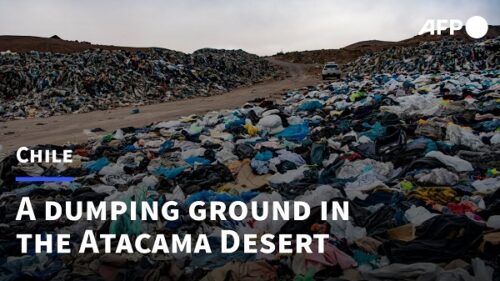26 Aug 2022
The effects of fast fashion on society, the environment and the young designers who the leather industry is trying to support, writes Dr Mike Redwood on ILM.

Clothing dumped in the Atacama desert in northern Chile
A recent headline from Wired describes the fast fashion industry as “Fast, Cheap and out of Control”. In April, the Chinese-based fast fashion company Shein has valued at US$100 billion are its latest funding round.
Given the inevitably large contribution that fashion and clothing make to our overall societal problems via the use of planetary resources, production of CO2 during manufacturing as well as shipping, waste and other areas like modern-day slave labour and damage to nature in supply chains, large companies in the sector will always be subject to scrutiny.
Shein in particular has a murky history after being founded in Nanjing in 2008 to produce affordable fashion but then recreated in 2012 after a split. Few people had heard about the company until the last three years when it burst to the fore and came to my attention after a young relation in Scotland found that her designs had been stolen.
A student in Dundee, she laser cuts jewellery and sells it online, initially borrowing college equipment for the process. At the start of the pandemic, she invested her income to set herself up with a small workshop at home to keep the business going through lockdowns. Towards the end of 2020, she discovered Shein was copying her designs.
It seems that Shein now admits that its policy of using external designs has led to a large number of design thefts from Instagram and Etsy postings. In places like the US, where Shein has offices, a few designers have sued and obtained limited financial compensation but very few young designers can afford this route and can only complain on social media.
My relative wrote: “KITSCHY is a one-woman brand. It’s just me. And this is the same for so many creatives. I design, I hand make, I package orders, I post orders, I organise the admin, I photograph my pieces, I maintain the website, I run the socials. There is so much of my heart, soul and time dedicated to making this something really special. This is the experience that brands like Shein cannot provide. This is any creator’s worst nightmare.”
Her Kitsch Angel Earrings were copied to the last detail, but with low-grade workmanship and non-hypoallergenic metal, all with a big cut in price as Shein is about huge volumes and prices so low that consumers do not expect too much.
Copying designs and sidestepping patent and IP rules is a recognised way to reduce costs and undercut the market, as is ignoring environmental and labour rules. According to Wired, investigation of Shein suppliers in China had shown that some 85% had major problems, many at the “zero tolerance” level. There are other clever things that Shein does to keep costs down with automated computing systems and the use of international small parcel movements, which stay below the levels for tax and the scrutiny that a container would receive.
Wired author Vauhini Vara bought 14 items of women’s clothing for US$80.16, including a dress at US$2.50 and a pullover for US$4.50. At the start of fast fashion 20 years ago, she wrote, a top for a night out was the cost of a takeaway, while Shein has reduced it to “undercut a deli sandwich”.
Fossil fuels are the key to fast fashion
What often gets missed is that the key to all this fast fashion is fossil fuels. Cheap synthetic fibres produced from fossil fuels, and proclaimed for the last 15 years as “the most environmentally sustainable materials” by major indices, have allowed the creation of ultra-cheap garments that struggle to stand more than one or two washes before being discarded. They fill our landfills and our wardrobes with quantities of waste, a situation never been seen before in the history of our planet.
When attacked on environmental grounds, companies like Shein are defended with the argument that, in difficult times, it is important that consumers are given access to affordable goods. The concepts of cost per wear or lifetime value are never considered, nor the damage that it is doing to the lives of others working in intolerable conditions elsewhere to achieve falsely low prices.
The figures that argued that synthetics were environmentally better than natural materials have now been shown to be wildly wrong, but they were always deliberately contextually restricted. They ignored the fossil fuel origins of the fibres, the low durability and short life in use, and it is only recently that we have been astonished to learn of the damage being created by plastics in the oceans, 35% of which reportedly come from synthetic clothing.
Companies like Shein remind us of what a mountain we have to climb and that, after nearly three decades of ever poorer and cheaper clothing built on total misconceptions of quality and value, we are still miles away from learning to change our ways.
We live in a moment when a company like Shein, through its subsidiary Romwe, will give a young influencer with an iPhone and a tripod free clothing and a fee for one TikTok video that exceeds a week’s income for a hardworking and committed young designer in Dundee who makes her own product. Precisely the sort of person we are striving to encourage.

使用條款 | 隱私政策 | APLF 可持續發展